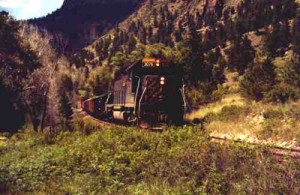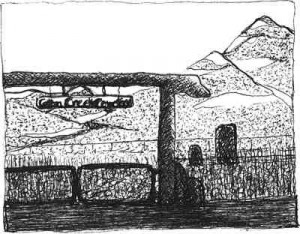Essay by Allen Best
Outdoor Recreation – February 2006 – Colorado Central Magazine
NEWS ACCOUNTS about fatal avalanches — and we’ve had nine deaths in the West this winter — sometimes give the impression that the difference between life and death is one easy piece of technology: an avalanche beacon.
If only the buried victim had been wearing a beacon, goes the story line, a life could have been saved. That turns a beacon into something resembling a safety belt for snowmobilers or skiers. I think the analogy is more like wearing a safety belt while going over a cliff.
The reality is far more complex. Beacons, also called transceivers, do help, if everybody is wearing one. But they are no backcountry magic amulet. In fact, there’s a gallows- humor saying about the devices: They help searchers find a dead body more easily.
What should be understood is how massively violent all but the smallest of avalanches are.
“It’s like getting sent through the spin cycle of a washing machine,” says Scott Toepfer, an avalanche forecaster in Colorado. A moving avalanche, he says, not only has a way of packing snow inside a person’s clothes; it also strips clothes off. This heaving, pummeling snow can fling its victims into trees and rocks. Studies have shown that approximately 25 percent of avalanche fatalities die not from suffocation or hypothermia, but by trauma.
Slab avalanches, in which the snow is like cardboard boxes or sometimes even small cars, are the most frequent and deadly avalanches. These blocks aren’t like plastic foam. Fluffy snowflakes of weeks and months past have already been transformed within the snowpack into something that more closely resembles a box of marbles. Once the snow starts tumbling, the friction heats these snow particles.
Then, only moments after the snow has quit moving, the snow sets up into something that has often been compared to hardened concrete. If that comparison seems a stretch, consider this: Avalanche debris weighs about 800 pounds per cubic yard.
“Go six feet down and you’re under a Buick,” says Toepfer. In fact, statistics show that almost nobody survives who ends up under more than six feet of snow, no matter how many beacons they’re wearing.
But even for those lucky enough to end up closer to the surface, avalanche debris is a prison. The snow creates a body cast. Occasionally, if they’re only inches below the surface, people have been able to dig themselves out. But even people who have been buried up to their waist have reported taking hours to extricate themselves.
Speed is of the essence in recovery. One Swiss study showed that 93 percent of avalanche victims survived if they’d been found within 15 minutes. The odds slide southward at a horrendous rate every minute beyond.
After 45 minutes underneath the snow, the odds are down to less than 30 percent survival. While different studies have yielded varying statistics, they all curve rapidly in the same direction.
An avalanche beacon can help speed this recovery. It all depends upon whether somebody is around who has one and knows how to use it. With luck, a search and rescue team will be near. But waiting for a trained crew to arrive probably dooms you. As the saying goes, “You got to dance with them what brung you.” Buddies who have been skiing, snowboarding or snowmobiling with you are your only hope, and they’d better dance fast.
IT’S LIKE Ginger and Fred, or lock and key. Some things in life come paired. Beacons only work with shovels. You can’t claw through anything that resembles concrete with your hands. Probes help. But ultimately, you need a shovel. That’s what I wish more of the news reports said. Beacons are of little value without shovels. Even then, your odds aren’t swell anytime you get in an avalanche. A curious corollary is how many experts who know all these statistics end up as avalanche victims. The draw of backcountry snow is intense. But even experts don’t know sure- fire technological fixes. Steep hillsides are flat- out dangerous at times, especially soon after storms.
So the next time you read about an avalanche victim, don’t be misled if the story suggests that the victim might yet be alive if only he (most avalanche victims are men) had been wearing a beacon. Crucial to each case is whether others with beacons were close by, whether they knew how to use them, and not least, whether companions had invested in something very low- tech and unglamorous: a shovel.
Allen Best is a contributor to Writers on the Range, a service of High Country News, (hcn.org) in Paonia, Colorado. He lives in the Denver area.


